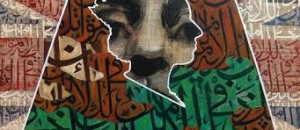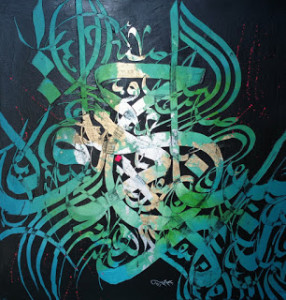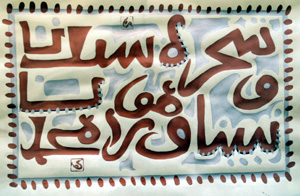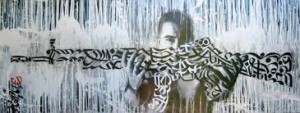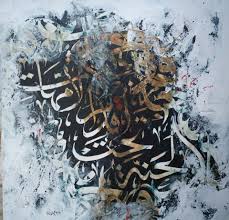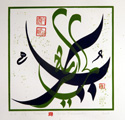The arabic script, as always, is used as a vehicle of art. An art characterized by the beauty. This writing has developed, since ancient times, an ornamental style, called arabesque and composed by calligraphic and / or geometric elements. Arabic script, in the Muslim world , is very important because it reflects the art of the spiritual world and it expresses the sacred text, al-Qurʾān. In fact, we find the art of calligraphy on the walls or in the mosques, on ceramics, coins or even wovens. In them are evoke, almost always, passages from the Koran. Contemporary artists in the Islamic world still exploit the heritage of calligraphic art to insert inscriptions or abstract figures in their works. Many of them develop cultural and political issues of intersection between Western and Eastern world. The traditional instrument of the Arabic calligrapher is qalam, a reed pen dry; the ink is often colored.
Among Iraqi artists stands out Ayad Alkadhi, he was born in 1971 in Baghdad. Alkadhi works mostly with charcoal, acrylic, pen and pencil, layered on top of the Arab newspaper applied to canvas, using scraps of news of war; and alluding to the Iraqi victims.
One of the greatest masters of contemporary calligraphy is Hassan Massoudy, he was born in 1944 in Najaf, in the southern of Iraq. The art of Hassan Massoudy bud from the encounter between the past and present, between Oriental art and Western art, between tradition and modernity. He frees himself from the art of classical calligraphy, simplifying and purifying the lines, discovering new horizons of color to a wider world and unlimited. His works cite maxims of great poets or ancient and contemporary writers of different cultures.
Another great artist is Giasim Muhammad. He was born in 1985 in Iraq. His works introduce abstract letters or passages of Koran and even popular poems such as those of al-Giawahiri or As-Sayab that they keep an enigmatic character. The sense of his works is not immediate to the public.
We can nominate still two other Iraqi artists: Mohammed Al Nouri and Wissam Al Haddad. Il primo nato in Iraq nel 1966. His graphic designs are elegant compositions of love poems or verses of the sacred text. The works of Wissam (unlike the artists listed above) are ceramic sculptures engraved with calligraphy using the land of Mesopotamia and the colors of Islam.
The Arab world and its culture calligraphy always has influenced artists of the Western world as Bibi Trabucchi; the first artist of Islamic calligraphy, not Muslim. She has fallen in love of calligraphic art traveling in the Middle East and she has specialized in a particular calligraphic style Iraq, the kufico. Her works, delicate and processed at the same time, are realized in china or tempera on parchment; many are the first development of a single word “peace” or rather “salam”.
“Everything starts with a breath, follows concentration and the gesture . When you stop? Not depend on me”
La scrittura araba, come sempre, viene utilizzata come mezzo di arte. Un’arte caratterizzata dalla bellezza. Questa scrittura ha sviluppato, fin dai tempi antichi, uno stile ornamentale, detto arabesco e composto da elementi di calligrafia e / o geometrici. La scrittura araba, nel mondo musulmano, è molto importante, perché riflette l’arte del mondo spirituale, essa è il veicolo attraverso il quale è espresso il testo sacro, al-Qur’ān. Infatti, l’arte della calligrafia, la troviamo sulle pareti o nelle moschee, su ceramica, monete o anche tessuti. In esse sono riprese, quasi sempre, brani del Corano. Gli artisti contemporanei del mondo islamico sfruttano ancora il patrimonio dell’ arte calligrafica per inserire iscrizioni o figure astratte nelle loro opere. Molti di loro sviluppano questioni culturali e politiche di intersezione tra mondo occidentale e orientale. Il tradizionale strumento del calligrafo arabo è il calamo, una penna a canna secca; l’inchiostro è spesso colorato.
Tra gli artisti iracheni spicca Ayad Alkadhi, nato nel 1971 a Baghdad. Alkadhi lavora per lo più con il carbone, acrilico, con penna e matita, strati soprapposti del giornale arabo applicati su tela, utilizzando frammenti di notizie della guerra; e alludendo alle vittime irachene.
Uno dei più grandi maestri di calligrafia contemporanea è Hassan Massoudy, nato nel 1944 a Najaf, nel sud dell’Iraq. L’arte di Hassan Massoudy nasce dall’incontro tra il passato e il presente, tra arte orientale e arte occidentale, tra tradizione e modernità. Si affranca dall’arte della calligrafia classica, semplificando e purificando le linee, alla scoperta di nuovi orizzonti di colore verso un mondo più vasto e illimitato. Le sue opere citano massime dei grandi poeti o scrittori antichi e contemporanei di culture diverse.
Un altro grande artista è Giasim Muhammad. Nato nel 1985 in Iraq. I suoi lavori presentano lettere astratte o passaggi del Corano e, ancora poesie popolari come quelli di al-Giawahiri o As-Sayab, che mantengono un carattere enigmatico. Il senso delle sue opere non è immediato al pubblico.
Possiamo ancora citare altri due artisti iracheni: Mohammed Al Nouri e Wissam Al Haddad. Il primo nato in Iraq nel 1966. Le sue elaborazioni grafiche sono eleganti composizioni di poesie d’amore o versi del testo sacro. Le opere di Wissam (a differenza degli artisti elencate sopra) sono sculture in ceramica incise con la calligrafia usando la terra della Mesopotamia e colori dell’Islam.
Il mondo arabo e la sua cultura calligrafica ha, da sempre, influenzato artisti del mondo occidentale come Bibi Trabucchi; la prima artista di calligrafia islamica, non musulmana. Si è innamorata dell’arte calligrafica viaggiando in Medio Oriente e si è specializzata in un particolare stile calligrafico dell’Iraq, il kufico. Le sue opere, delicate ed elaborate allo stesso tempo, sono realizzate in china o tempera su pergamena; molte sono una prima elaborazione di una singola parola ” pace” ovvero “salam”.
“Tutto nasce con un respiro, la concentrazione e il gesto segue. Quando si interrompe? Non dipende da me”

